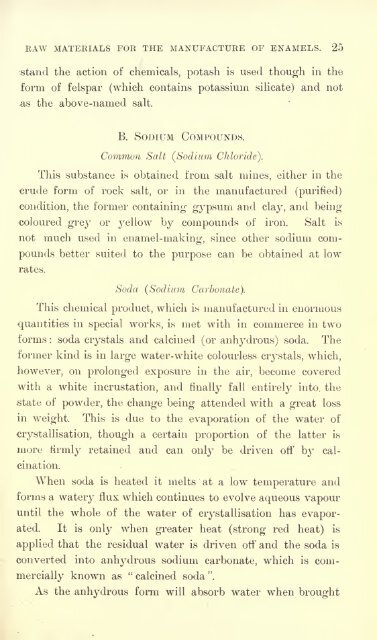Enamels and enamelling; an introduction to the preparation and ...
Enamels and enamelling; an introduction to the preparation and ...
Enamels and enamelling; an introduction to the preparation and ...
You also want an ePaper? Increase the reach of your titles
YUMPU automatically turns print PDFs into web optimized ePapers that Google loves.
RAW MATERIALS FOR THE MANUFACTURE OF ENAMELS. 25<br />
st<strong><strong>an</strong>d</strong> <strong>the</strong> action of chemicals, potash is used though in <strong>the</strong><br />
form of felspar (which contains potassium silicate) <strong><strong>an</strong>d</strong> not<br />
as <strong>the</strong> above-named salt.<br />
B. SODIUM COMPOUNDS.<br />
Common Salt (Sodium Chloride).<br />
This subst<strong>an</strong>ce is obtained from salt mines, ei<strong>the</strong>r in <strong>the</strong><br />
crude form of rock salt, or in <strong>the</strong> m<strong>an</strong>ufactured (purified)<br />
condition, <strong>the</strong> former containing gypsum <strong><strong>an</strong>d</strong> clay, <strong><strong>an</strong>d</strong> being<br />
coloured grey or yellow by compounds of iron. Salt is<br />
not much used in enamel-making, since o<strong>the</strong>r sodium com-<br />
pounds better suited <strong>to</strong> <strong>the</strong> purpose<br />
rates.<br />
Soda (Sodium Carbonate).<br />
c<strong>an</strong> be obtained at low<br />
This chemical product, which is m<strong>an</strong>ufactured in enormous<br />
qu<strong>an</strong>tities in special works, is met with in commerce in two<br />
forms : soda crystals <strong><strong>an</strong>d</strong> calcined (or <strong>an</strong>hydrous) soda. The<br />
former kind is in large water-white colourless crystals, which,<br />
however, on prolonged exposure in <strong>the</strong> air, become covered<br />
with a white incrustation, <strong><strong>an</strong>d</strong> finally fall entirely in<strong>to</strong>, <strong>the</strong><br />
state of powder, <strong>the</strong> ch<strong>an</strong>ge being attended with a great loss<br />
in weight. This is due <strong>to</strong> <strong>the</strong> evaporation of <strong>the</strong> water of<br />
crystallisation, though a certain proportion of <strong>the</strong> latter is<br />
more firmly retained <strong><strong>an</strong>d</strong> c<strong>an</strong> only be driven off by cal-<br />
cination.<br />
When soda is heated it melts at a low temperature <strong><strong>an</strong>d</strong><br />
forms a watery flux which continues <strong>to</strong> evolve aqueous vapour<br />
until <strong>the</strong> whole of <strong>the</strong> water of crystallisation has evapor-<br />
ated. It is only when greater heat (strong red heat) is<br />
applied<br />
that <strong>the</strong> residual water is driven off <strong><strong>an</strong>d</strong> <strong>the</strong> soda is<br />
converted in<strong>to</strong> <strong>an</strong>hydrous sodium carbonate, which is com-<br />
mercially known as " calcined soda ".<br />
As <strong>the</strong> <strong>an</strong>hydrous form will absorb water when brought
















